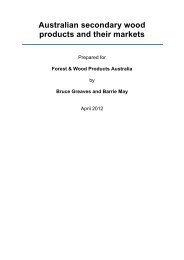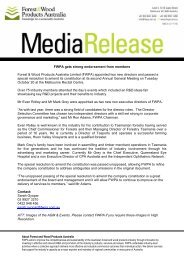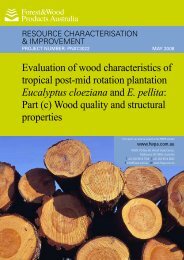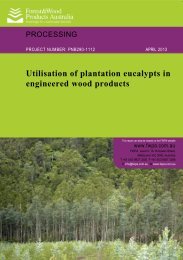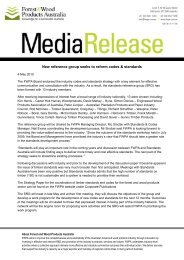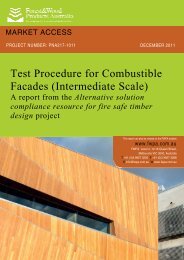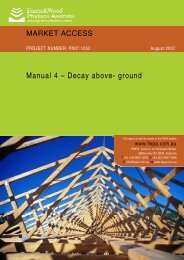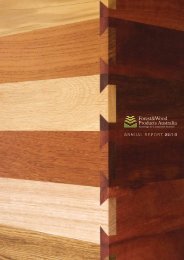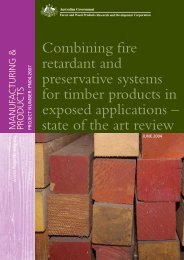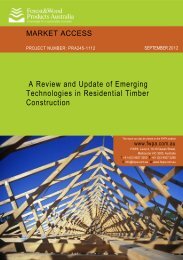Predicting the water-use of Eucalyptus nitens plantations in ...
Predicting the water-use of Eucalyptus nitens plantations in ...
Predicting the water-use of Eucalyptus nitens plantations in ...
Create successful ePaper yourself
Turn your PDF publications into a flip-book with our unique Google optimized e-Paper software.
• FEMs represent <strong>the</strong> best available source <strong>of</strong> <strong>in</strong>formation about <strong>the</strong> plantation<br />
and forest estate, <strong>in</strong>clud<strong>in</strong>g species, structure, management and growth. The<br />
quality <strong>of</strong> this <strong>in</strong>formation is improv<strong>in</strong>g all <strong>the</strong> time as new data are<br />
<strong>in</strong>corporated.<br />
• FEMs are optimisation tools that allow a range <strong>of</strong> scenarios to be assessed<br />
given a host <strong>of</strong> constra<strong>in</strong>ts and <strong>the</strong>y are able to compare <strong>the</strong> f<strong>in</strong>ancial<br />
outcomes, wood production, product mix and stand<strong>in</strong>g volumes that will result<br />
from various scenarios.<br />
• FEMs can schedule events over long periods to best allow management<br />
objectives to be achieved.<br />
A simple empirical model l<strong>in</strong>ks E. <strong>nitens</strong> plantation <strong>water</strong>-<strong>use</strong> to plantation basal area. Most<br />
Australian attempts to quantify <strong>the</strong> effects <strong>of</strong> <strong>plantations</strong> on <strong>water</strong> resources have focussed on<br />
streamflow ra<strong>the</strong>r than <strong>water</strong>-<strong>use</strong> and none have attempted to l<strong>in</strong>k with exist<strong>in</strong>g forest<br />
management tools. Forest companies do not manage entire catchments, do not know where<br />
all streams are or how much <strong>water</strong> is dra<strong>in</strong><strong>in</strong>g from <strong>the</strong>m and do not have <strong>the</strong> tools or<br />
capacity to operate catchment models for anyth<strong>in</strong>g o<strong>the</strong>r than small-scale studies. This makes<br />
streamflow an impractical basis for plann<strong>in</strong>g forest management to benefit <strong>water</strong> resources.<br />
The National Water Initiative recognises that large-scale plantation forestry may <strong>in</strong>tercept<br />
significant volumes <strong>of</strong> <strong>water</strong>, and makes provision for <strong>the</strong> regulation <strong>of</strong> large-scale plantation<br />
forestry to reduce <strong>the</strong> risk to <strong>water</strong> access entitlements or to achieve environmental<br />
objectives. Forest <strong>in</strong>dustry, land managers and regulators are not currently <strong>in</strong> a position to<br />
quantify large-scale plantation <strong>in</strong>terception <strong>in</strong> a way that takes account <strong>of</strong> <strong>the</strong> variation that<br />
occurs <strong>in</strong> <strong>in</strong>terception <strong>in</strong> response to plantation health and growth. Incorporation <strong>of</strong> <strong>water</strong>-<strong>use</strong><br />
data <strong>in</strong> FEMs could produce <strong>water</strong> <strong>in</strong>terception predictions for <strong>plantations</strong> to <strong>in</strong>form <strong>the</strong>se<br />
decisions.<br />
37



